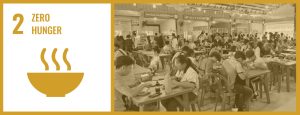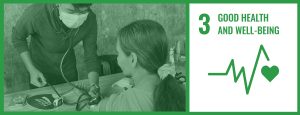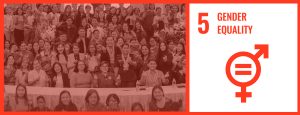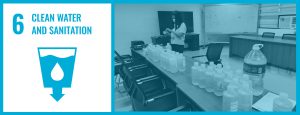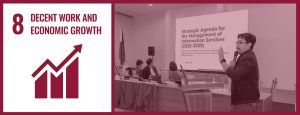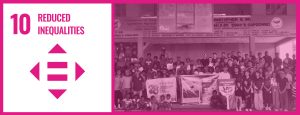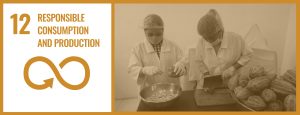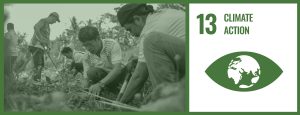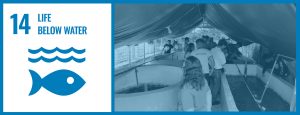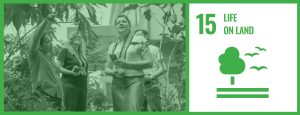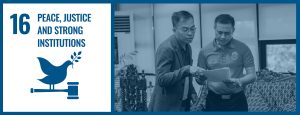2024 Research | SDG 8 – Decent Work and Economic Growth
Research Programs
Rearing Performance of Pangasius (Pangasius sp.) Fed Diet with Different Levels of Amaranthus spinosus Stalk Meal
Proponents: JIsagani P. Angeles, Jr., Laila M. Gallego
Abstract
The study evaluated the rearing performance, percentage survival, and cost and return analysis of Pangasius sp. grow-out production fed diet with different levels of Amaranthus spinosus stalk meal (ASSM). Pangasius sp. were fed diet with ASSM25 (25% ASSM), ASSM75 (75% ASSM) and a diet without ASSM served as control (C). Results revealed that fish fed diet with ASSM25, C, and ASSM50 has no significant difference in the final weight (Wf), weight gain (WG), and specific growth rate (SGR). For FCR, ASSM25 is lower than that of ASSM75 but comparable to C and ASSM500. There was also no significant difference in the percentage survival (SUR) of Pangasius sp. after ten weeks of rearing. Overall, results suggested that supplementation of ASSM could be a potential feed ingredient for the diet of Pangasius sp. up to 50% of the inclusion level. This data promotes sustainable aquaculture practices and should be considered in pangasius rearing.
Impact Assessment of Extension Activities in College of Education at ISU-E
Proponent: Mario P. Tamana
Abstract
This descriptive study aimed to assess the impact of extension activities and the challenges encountered by the community extension providers in the implementation of the approved extension activities in the College of Education at Isabela State University – Echague Campus. Frequency counts and percentages were used. The mean, on the other hand, was also used to determine the impact of extension activities. Results revealed that positive perceptions of extension activities among respondents, emphasizing their role in social and economic development. While challenges exist, particularly in optimizing training times and addressing occasional weather disruptions, the overall implementation of extension programs is effective. Strategic improvements in training, communication, and adaptive management practices are recommended to further enhance program impact and sustainability. The study recommends that the existing college extension training activities may be continued and further enhanced taking into considerations the assessment made on various criteria that were identified. Faculty of the College of Education are encouraged to continue their best practices in terms of planning, disseminating, and Monitoring and evaluation of the approved extension activities. Problems that were encountered such as time allocation in the conduct of extension activities and the use of their own materials or equipments during return demonstration as well as difficulty in the consolidation of reports need to be addressed immediately in order to come up with a more responsive extension training activities. Though there are problems that were “rarely” encountered by the clientele these need not be neglected rather course of actions or interventions need to be addressed. The college extension unit may request assistance from the university for the provision of vehicle in going to the adopted barangay or school when conducting extension activities.
Project: Upscaling of Postharvest Processing and Shelf-Life of Oyster Mushroom Study: Processing of Mushroom Loaf
Proponents: Melody E. Lim, Arlene I. Remigio, Ma. Leonila Cabaccan
Abstract
This study aims to evaluate the acceptability of mushrooms as a meat substitute in loaf and siomai. The products were assessed based on appearance, flavor, texture, aroma, and overall acceptability, and a cost-return analysis was conducted for each treatment. Data were analyzed using a Randomized Complete Block Design (RCBD). Results revealed that the experimental treatments using pure mushrooms demonstrated comparable attributes – appearance, flavor, texture, aroma, and general acceptability – to the control group, with the 30 panelists rating them as “like very much”. However, the aroma of loaf made with varying proportions of mushrooms was not comparable to the control, receiving a “like moderately” rating. The highest net income was achieved in the pure mushroom treatment (T4), which the panelists rated as “likely slight”.
Project: Upscaling of Postharvest Processing and Shelf-Life of Oyster Mushroom Study: Processing of Mushroom Steamed Dumpling
Proponents: Melody E. Lim, Arlene I. Remigio, Ma. Leonila Cabaccan
Abstract
This study presents the results of a sensory evaluation conducted to assess the attributes of oyster mushroom gyoza, with participation from 50 evaluators. The gyoza were evaluated based on five sensory attributes: appearance, aroma, texture, taste/flavor, and general acceptability, using a 1-9 hedonic scale where 1 indicates ‘dislike extremely.” The results demonstrated that the gyoza had a mean appearance score of 7.6, indicating favorable visual appeal. Aroma received a mean score of 7.2, suggesting general appreciation but less impact on the overall experience. The texture was highly rated with a mean of 7.8, showcasing a successful combination of the soft wrapper and tender filling. The taste/flavor emerged as the standout attribute, achieving a mean score of 8.3, reflecting strong satisfaction attributed to the umami-rich filling of the oyster mushrooms. The overall acceptability score of 8.0 confirmed that the gyoza were well-liked by the evaluators. The findings highlight the strong visual appeal, favorable texture, and particularly satisfying flavor of the oyster mushroom gyoza, establishing them as a successful plant-based alternative to traditional meat-filled dumplings.
The Credit Risk Management of Agricultural Cooperatives in Isabela Province during the COVID-19 Pandemic
Proponent: Fler L. Madayag
Abstract
Cooperatives are an integral part of the economic framework. They are an important source of finance for people and companies of all kinds, acting as a safety net for savings. During the period of Covid-19 pandemic, these coopeartives are exposed to credit risk. Since implementing risk management techniques are expensive, cooperatives have found it difficult to mitigate credit risk, which might lead to a spike in deliquency rates and cause issues for the cooperatives’ financial position. This study, which combined qualitative and quantitative methods, examined the cooperative’s exposure to credit risk, its effectiveness in implementing credit risk management strategies, and the challenges that these sixteen agricultural cooperatives in Isabela encountered in mitigating credit risk. A four-point Likert scale survey questionnaire, an open and closed-ended interview questionnaire, and information from financial statements and annual reports were used to collect data. The study’s findings revealed that agricultural cooperatives in Isabela are exposed to low level of credit risk. It also showed that a broad spectrum of activities,including identification, evaluation, and mitigation, had been implemented to reduce credit risk. Furthermore, even if the majority of cooperative still face various challenges in implementing risk management.
“Innovative Approaches to Processed Meat Production: Improving Quality, Safety, and Sustainability”
Proponent: Mary Grace C. Buraga
Abstract
The study addresses the growing consumer awareness and negative perceptions surrounding processed foods by innovating healthier and more acceptable alternatives using locally sourced ingredients. Conducted in response to findings by the International Food Information Council, which indicated that 43% of primary grocery shoppers view processed foods unfavorably, this research focuses on developing innovative processed meats. Using banana stem as a natural flavor enhancer for longganisa and substituting traditional ingredients in tocino with pineapple wine and calamansi extract, the study employs a descriptive experimental method to evaluate product acceptability. Respondents, including food and service management faculty, community members, and food producers,
assessed the products based on appearance, color, aroma, taste, and texture using a seven- point Hedonic rating scale. The analysis, using weighted mean, aims to identify nutritional
content and determine shelf life. Results shows that the acceptability of innovative processed meats, specifically tocino and longganisa, using locally sourced ingredients to address consumer concerns
about processed foods are well-received by the consumers. The sensory attributes of appearance, color, aroma, taste, and texture were assessed by three groups: FSM students, food experts, and community members. Tocino was highly rated across all sensory criteria,with community members giving the highest overall acceptability score (Grand Weighted Mean = 6.20). Longganisa also received positive ratings, particularly from FSM students (Grand Weighted Mean = 6.03), although food experts rated its appearance and texture as slightly acceptable. The study demonstrates that both tocino and longganisa are well-received by consumers, with potential for market success. The findings highlight the importance of natural flavor enhancements and minimal processing in meeting consumer expectations for healthier processed food options. This approach not only offers a
sustainable model for food innovation but also supports local economies through the use of indigenous raw materials.
Acceptability of Slender Amaranth, Lemon Grass and Philippine lime as mixed juice drink
Proponent: Honelyn D. Farala
Abstract
This study evaluates the acceptability of three-juice drinks formulated from slender amaranth, lemongrass, and Philippine lime, focusing on sensory attributes such as appearance/color, aroma/odor, taste/flavor, and texture. Three different treatments were assessed by respondents using a 9-point hedonic scale. The results indicate high acceptability across all treatments, with mean scores ranging from 7.82 to 8.61, all falling within the “Like Very Much” category. Treatment 3 emerged as the most preferred formulation, achieving the highest mean scores for appearance/color (M = 8.46), aroma/odor (M = 8.44), and texture (M = 8.61). One-way ANOVA revealed significant differences in taste/flavor (F = 5.830, p = 0.004) and texture (F = 4.254, p = 0.016), favoring Treatments 2 and 3 over Treatment 1. Post hoc analysis using Tukey’s multiple comparison test confirmed these differences, with Treatment 1 rated significantly lower in taste and texture compared to Treatments 2 and 3. The findings suggest that specific mixture ratios enhance sensory properties, particularly for Treatments 2 and 3. The high acceptability ratings indicate strong potential for these formulations as commercially viable products. Treatment 3 should be prioritized for further refinement and promotion as a premium offering within the market. The study provides valuable insights for product development and marketing strategies aimed at enhancing the appeal of functional beverages, ultimately contributing to their success in a competitive market.
“A Taste of Passion: Acceptability of Coconut Curd (Latik) Macaroons”
Proponent: Ma. Theresa R. Respicio
Abstract
The study aimed to determine the acceptability of banana cake, carrot cake and macaroons. The experimental method of research was used with the survey questionnaire as the main data gathering instrument. The study used the nine-point Hedonic rating scale in evaluating the product’s acceptability in terms of appearance, color, aroma, taste and texture. Twenty (20) Food and Service Management students, twenty (20) food experts, and twenty (20) community people a total of sixty (60) were the respondents of the study. The statistical tools used in the study were weighted mean and standard deviation. Results of the study revealed that the Macaroons had the highest acceptability and with consistent rating across all the respondents, thus it indicates that the coconut macaroons have the potential to be a viable and appealing local product in the market. Meanwhile the acceptability of the banana cake was also very high which indicated that it could also be a dependable option. However, with regards to the carrot cake, refinement and adjustment are needed to meet community people’s preference while not affecting the positive perception of the FSM student and food experts. In the aspect of nutritional content, all baked products
Empowering Communities: Design,Fabrication, and Evaluation of Mobile Solar-Powered Charging Stations with Integrated Street Lighting and Automated Water Refilling Station for Disaster Resilience
Proponents: Jolan Baccay Sy, Jake La Madrid, Allen M. Paz
Abstract
This study investigates the design, fabrication, and evaluation of mobile solar-powered charging stations integrated with street lighting and automated water refilling systems, aimed at enhancing disaster resilience in rural communities, particularly at the Cabagan Riverside Evacuation Center. The primary objectives were to address energy and water accessibility challenges during natural disasters, develop functional designs for diverse community needs, and utilize sustainable materials for durability.
The innovative approach combines solar-powered charging, street lighting, and automated water refilling into a single mobile unit. Engineered to provide essential energy, lighting, and water access for one week in disaster-affected areas, the station features a lightweight frame, high-efficiency solar panels (330 watts), and a 100Ah battery. Multiple USB ports facilitate device charging, while integrated LED lighting enhances nighttime safety. The automated water refilling system employs ultrasonic sensors and an Arduino microcontroller for efficient water dispensing. Evaluation through a structured questionnaire revealed significant improvements in energy access and safety, with high satisfaction among community members. This study underscores the potential of solar-powered solutions to strengthen disaster resilience and promote sustainability in vulnerable regions, offering valuable insights for policymakers and practitioners in disaster management.
Comparative Analysis of the Profitability of Small-Scale Monoculture and Diversified Yellow Corn Production Farms in Cabagan, Isabela
Proponent: Michelle Ann M. Calubaquib,Ph.D
Abstract
The study aimed to compare the profitability of small-scale monoculture and diversified yellow corn production farms in Cabagan, Isabela. It sought to characterize the socio- demographic profile of farmers, compare their farming practices, and determine profitability. The research was conducted through house-to -house survey of 30 farmers engaged in monoculture and 30 farmers practicing diversified farming. The findings revealed that oldr farmers predominantly practice both farming systems, with monoculture farming involving more male farmers (70%) and diversified farming having a higher proportion of female farmers (60%). Most farmers in both systems are married and have educational background ranging from elementary to high school levels. Income levels are generally low, with diversified farming showing a broader income distribution. In term of cultural management practices, monoculture farmers rely more on tractors (80%), mechanical seeders (75%), and herbicides (90%), ehile diversified farmers prefer traditional methods such as manual planting (65%), and araro (plowing)(60%). Monoculture farming incurs higher cash cost due to greater dependenceon fertilizers and labor, leading to potential soil degradation .In contrast, diversified farming employs a variety of water sources and integrates more manual labor in seed preparation, planting, and water management, resulting in lower input costs. The gross profit margin ratio for monoculture farming is 0.82, meaning they retain 0.82 centavos per every peso of income after covering the cost of goods sold, compared to 0.67 centavos for diversified farmers. Monoculture farming offers higher immediate profit margins but demands more input and is more susceptible to soil degradation and pest issues. Diversified farming, while yielding lower profit margins, provides sustainability benefits through reduced input cost and labor savings.
EVALUATION OF ROUGH RICE GRADING USING THERMAL IMAGING TECHNOLOGY
Proponents: ORFEL L. BEJARIN, MARIBEL S. ABALOS
Abstract
Rough rice is an unhusked grain of Oryza sativa that contains the hull and glumes. Rough Rice Grading, which consists of a collection of defined procedures and methods for determining quality, is an important part of marketing and process controls. To identify the heat that has been released, IR thermography makes use of the infrared wavelengths of the electromagnetic spectrum. To capture images of the sample, a FLIR One thermal camera was used. The average value of the thermal image’s pixels was used to create a thermal index that served as a representation of each sample. In this study, Evaluation of rough rice grading using thermal imaging technology, infrared thermography and image processing techniques were employed to evaluate the grading of rough rice. The study showed that employing infrared thermography yielded 98.8% accuracy in classifying the rice grades. This technology has been particularly successful at discerning quality characteristics, resulting in more effective sorting and evaluation processes for rice production and quality management. The findings showed that rough rice’s moisture content could be precisely determined using infrared thermography evaluation with spectrum analysis.
Enhancing Graduate Job Concordance Tracking with AI-Based Matching Algorithms
Proponents: Mark Gil T. Gañgan 1 and Jhoan V. Paguirigan
Abstract
The web-based Graduate Job Concordance tracking system, utilizing AI-based matching algorithms, serves as an innovative platform for assessing the relevance of employment secured by BSIT graduates in relation to their academic qualifications. This study employs an Iterative Software Development Methodology alongside a Text Mining Model to create the platform, which integrates matching algorithms to facilitate effective job relevance assessment. The text mining model offers a structured approach for preprocessing, transforming, and classifying job titles through machine learning algorithms. The front-end of the platform is developed using HTML, CSS, and JavaScript, while the back-end is powered by PHP and MySQL, ensuring a robust and user-friendly interface. This choice of technology underscores the platform’s cost-effectiveness, leveraging open-source tools that offer customization flexibility and access to a wealth of support and expertise. The research presents a novel solution that bridges the gap between higher education institutions and the ever-evolving employment market. By harnessing AI technology, particularly through the implementation of three text analysis algorithms—Cosine Similarity, Euclidean Distance, and Jaccard Similarity—the study identifies the Cosine Similarity algorithm as the most effective for determining job concordance among BSIT graduates. To evaluate the system’s performance, respondents assessed it against the ISO 25010 standards, focusing on functional suitability, usability, and reliability. The system achieved an impressive overall rating of 4.36, indicative of a “Strongly Agree” consensus among users. Ultimately, this study contributes to the enhancement of academic programs, aligning them more closely with industry needs. Furthermore, it equips educational institutions, accreditation agencies, and policymakers with data-driven insights for informed decision-making, ultimately benefiting both students and the broader industry landscape.
An Assessment of the Consumer Behavior on Value-Added Products Towards Marketing Strategies
Proponent: Mary Ann B. Mamauag, DHM
Abstract
This study assessed the consumer behavior and preferences concerning value-added products from ISU San Mariano Campus, employing a descriptive research method. Analysing respondents’ states of mind, mood swings, and feelings, the research aims to understand buying behavior, with satisfaction as an intervening variable. Data from the respondents, revealed high education levels and privileged circumstances. Consumers prioritize both price and quality, emphasizing competitive pricing and informative packaging. While satisfaction is moderate, improvements in usability and information clarity are needed. Personal interaction and information gathering significantly affects buying behavior, necessitating comprehensive marketing strategies. Results on the product pricing, both genders prioritize price and quality, with males showing a stronger inclination for detailed assessments. Younger and higher-educated consumers are particularly sensitive, while lower-income groups are more price-sensitive. Packaging attributes significantly affects purchasing decisions, with females exhibiting higher agreement. Younger and higher-educated consumers prioritize packaging attributes more. Satisfaction levels vary by gender, age, education, and income, influencing buying behavior. Marketing strategies should align with consumer preferences, emphasizing value-based pricing, sustainable packaging, and targeted segmentation to enhance product appeal and success. Future research could explore interventions to enhance usability, information clarity, and cultural factors’ intersections, aiding strategic planning and maximizing consumer engagement and loyalty.
Enhancing the Basic Services on the Implementation of Sustainable Development Goals: The Municipality of San Mateo Case
Proponents: Rosalie C. Leal, Venus A. Diego
Abstract
The paper examines the role of Local Government Units (LGUs) in providing quality basic services in accordance with the United Nations’ Sustainable Development Goals (SDGs), specifically in the municipality of San Mateo, Isabela. The study seeks to confirm their accomplishments by evaluating the execution of fundamental services in accordance with the Sustainable Development Goals (SDGs). It concentrates on certain Sustainable Development Goals associated with agriculture, infrastructure, health, environmental management, tourism, education, and social services, highlighting the interaction between political and governance frameworks.
The study evaluates fundamental services, the integration of Sustainable Development Goals (SDGs), levels of satisfaction, and disparities among respondent groups, while proposing improvement initiatives. Results indicate significant integration and favorable evaluations, demonstrating a dedication to global sustainability. San Mateo’s distinguished status and multiple accolades highlight its dedication to the Sustainable Development Goals (SDGs). This research concludes that San Mateo delivers services equally, emphasizing inclusivity and equality. The affirmative association between integration and satisfaction underscores the significance of aligning services with sustainable development concepts. Recommendations encompass ongoing enhancement, needs assessments, periodic evaluations, community satisfaction surveys, adaptive action plans, and a specialized monitoring division. The study adds to what is known about sustainable development in local government by showing how integration, satisfaction, and the success of implementing the SDGs in LGU San Mateo are all connected.
Assessing the Food Service Industry Workforce Needs: The Employers’ Perspective on Technical and Management Competency and Employability of BSHM University Graduates
Proponent: Dr. Mildred V. Matulin
Abstract
The food service industry plays a crucial role in driving economic growth where graduates of the Bachelor of Science in Hospitality Management (BSHM) program are required to adapt to changing competency standards. This study utilized a qualitative descriptive research design, collecting data via open-ended questions with food service employers in Cauayan City to assess their perspectives on the technical and managerial skills of BSHM graduates. The findings indicate that employers place a high value on qualities like self-motivation, adaptability, and effective communication skills, all of which are crucial for thriving in a fast-paced work environment. Moreover, employers highlighted the significance of hands-on experience and a professional demeanor, suggesting that recent graduates ought to possess both technical knowledge and interpersonal abilities. The results highlight an essential requirement for higher education institutions to synchronize their curricula with industry needs by incorporating practical training, refining communication skills, and deepening students’ comprehension of career trajectories. This study finds that tackling these skill gaps will greatly improve the employability of BSHM graduates and equip them more effectively for the challenges present in the food service industry.
Employment Outcomes and Career Choices: A Tracer Study of Hospitality Management Graduates (2019-2023)
Proponents: Dr. Ma. Edel Lourdes A. Galiza & Raiza O. Ventura
Abstract
This study examines employment outcomes and career choices of Bachelor of Science in Hospitality Management graduates between 2019 and 2023. Data from 402 graduates revealed varying employment rates, with a resurgence in the hospitality industry in 2022 and 2023. Suggestions include monitoring employment trends, improving career education programs, fostering resilience, emphasizing technological literacy, expanding skill sets, advocating for supportive policies, and promoting lifelong learning to align educational programs with industry demands and promote long-term success.
Designing and Construction of Posture Brace Integrating Backpack Functionality
Proponent: Ronald B. Isidro Jr
Abstract
This paper explores the design and construction of a posture brace with integrated backpack functionality. The device is intended to correct posture and reduce the risk of back pain while also serving as a functional, everyday backpack. This dual-purpose solution is aimed at students and professionals who carry heavy loads, seeking to improve spinal alignment and reduce the strain on muscles. Prototyping and testing demonstrate that this design offers significant ergonomic advantages over traditional backpacks.
Design and Production of Abdominal Brace Contraption Merged with the Function of Utility Apparel
Proponent: Ronald B. Isidro Jr
Abstract
The researcher explored the design and production of an abdominal brace integrated with utility apparel functionality. The aim of the research is to create a contraption that not only provides abdominal support but also incorporates practical storage solutions, enhancing convenience for users who require additional physical support. Prototyping and evaluation of the product indicate the potential of such hybrid designs to improve both health and productivity in daily life.
Designing a User-Centered Gym Bag: Functionality and Hygiene Solutions for Active Individuals
Proponent: Dr. Sheryl D. Tomas
Abstract
This study investigates the design and creation of a versatile gym bag, employing Tim Brown’s Design Thinking technique to meet the particular requirements of fitness enthusiasts. This study highlights the significance of developing eco-friendly products that resonate with customer values, amid the growing emphasis on sustainability in the fitness industry. Utilizing user-centered research with 20 participants, essential features were discerned, such as hygiene, organization, and functionality. The design incorporates a vented compartment for moist garments, a waterproof shoe pocket, and specific storage for lifting gloves and personal goods, hence improving cleanliness and user experience. Participants’ feedback affirmed the efficacy of these treatments, emphasizing the bag’s contribution to hygiene and convenience while exercising. Furthermore, utilizing locally woven handloom fabrics as sustainable materials not only reduces environmental effect but also bolsters local weavers, promoting economic development within their communities.1 This study enhances the promotion of sustainability in product design, demonstrating how intentional design may satisfy customer needs while fulfilling wider social obligations. This research’s gym bag exemplifies a prototype for future advancements in the fitness industry, demonstrating the capacity of design thinking to produce functional, visually appealing, and socially responsible products.
Developing a Tool-Ready Carpenters’ Bag: Safety, Efficiency, and Durability in the Field
Proponent: Dr. Sheryl D. Tomas
Abstract
This study examines the design and creation of a carpenter’s bag, utilizing Tim Brown’s Design Thinking process as the foundational framework. The project aims to develop a functional and ergonomic backpack specifically designed for carpenters, acknowledging the distinct obstacles they encounter in challenging situations that necessitate mobility and safety. Insights were obtained from carpenters concerning their needs for tool organization, accessibility, and safety through a sequence of user-centered phases: empathize, define, ideate, prototype, and test. Identified key characteristics were a harness hook for secure attachment during climbing, hands-free movement, and compartments for convenient access to vital tools.
Although the original aim was to employ indigenous handloom fabrics to enhance local craftsmanship, the research encountered considerable obstacles related to the material’s durability and safety standards. As a result, the advancement of the bag prototype was halted to emphasize practical integrity over aesthetic considerations. This decision highlights the imperative for cooperation among designers, textile manufacturers, and artisans to develop materials that comply with contemporary safety standards while respecting cultural history. This study underscores the necessity of incorporating user feedback into product design and advocates for ongoing investigation of sustainable solutions that bolster the local textile industry while meeting the practical requirements of experts in the sector.
Creating the Ultimate Teachers’ Carry-All: Organizational Solutions for the Modern Educator
Proponent: Dr. Sheryl D. Tomas
Abstract
This project investigates the design and development of a versatile carry-all bag for educators, employing Tim Brown’s Design Thinking methodology to tackle the specific issues encountered by instructors. The research prioritized ergonomic functionality and organization, conducting interviews with 20 individuals to ascertain essential design criteria. The iterative design process included five phases: empathize, define, ideate, prototype, and test, culminating in a final prototype with a padded laptop compartment, a designated mobile phone pocket, organized pouches for educational resources, and an ergonomic design for daily comfort. User testing demonstrated that the bag markedly enhanced teachers’ productivity and comfort, alleviating physical strain and improving organization. Moreover, the concept underscored the integration of indigenous textiles, fostering local artisanship and rejuvenating ancient weaving methods. This research underscores the significance of user-centered design in the development of teachers bags, establishing a benchmark for future partnerships that integrate functionality with cultural heritage and sustainability in education.


